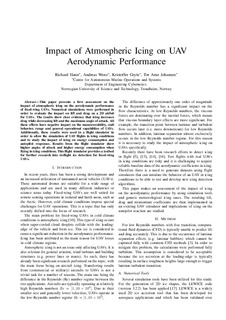| dc.contributor.author | Hann, Richard | |
| dc.contributor.author | Wenz, Andreas Wolfgang | |
| dc.contributor.author | Gryte, Kristoffer | |
| dc.contributor.author | Johansen, Tor Arne | |
| dc.date.accessioned | 2018-01-04T14:30:56Z | |
| dc.date.available | 2018-01-04T14:30:56Z | |
| dc.date.created | 2017-12-09T16:34:39Z | |
| dc.date.issued | 2017 | |
| dc.identifier.citation | 2017 Workshop on Research, Education and Development of Unmanned Aerial Systems (RED-UAS) | nb_NO |
| dc.identifier.isbn | 978-1-5386-0938-5 | |
| dc.identifier.uri | http://hdl.handle.net/11250/2475773 | |
| dc.description.abstract | This paper presents a first assessment on the impact of atmospheric icing on the aerodynamic performance of fixed-wing UAVs. Numerical simulations were performed in order to evaluate the impact on lift and drag on a 2D airfoil for UAVs. The results show clear evidence that icing increases drag while decreasing lift and the maximum angle of attack. All these effects have negative impact on the maneuverability, stall behavior, range and general operational capabilities of UAVs. Additionally, these results were used in a flight simulator in order to allow the simulation of UAV flights in icing conditions and to study the impact of icing on energy consumption and autopilot responses. Results from the flight simulator show higher angles of attack and higher energy consumption when flying in icing conditions. This flight simulator provides a testbed for further research into in-flight ice detection for fixed-wing UAVs. | nb_NO |
| dc.language.iso | eng | nb_NO |
| dc.publisher | IEEE | nb_NO |
| dc.relation.ispartof | 2017 Workshop on Research, Education and Development of Unmanned Aerial Systems (RED-UAS) | |
| dc.title | Impact of Atmospheric Icing on UAV Aerodynamic Performance | nb_NO |
| dc.type | Chapter | nb_NO |
| dc.description.version | acceptedVersion | nb_NO |
| dc.identifier.doi | 10.1109/RED-UAS.2017.8101645 | |
| dc.identifier.cristin | 1525182 | |
| dc.relation.project | Norges forskningsråd: 223254 | nb_NO |
| dc.relation.project | Norges forskningsråd: 237906 | nb_NO |
| dc.relation.project | EC/H2020/642153 | nb_NO |
| dc.description.localcode | © 2017 IEEE. This is the authors' accepted version of the manuscript. Personal use of this material is permitted. Permission from IEEE must be obtained for all other uses, in any current or future media, including reprinting/republishing this material for advertising or promotional purposes, creating new collective works, for resale or redistribution to servers or lists, or reuse of any copyrighted component of this work in other works. | nb_NO |
| cristin.unitcode | 194,63,25,0 | |
| cristin.unitname | Institutt for teknisk kybernetikk | |
| cristin.ispublished | true | |
| cristin.fulltext | postprint | |
| cristin.qualitycode | 1 | |
